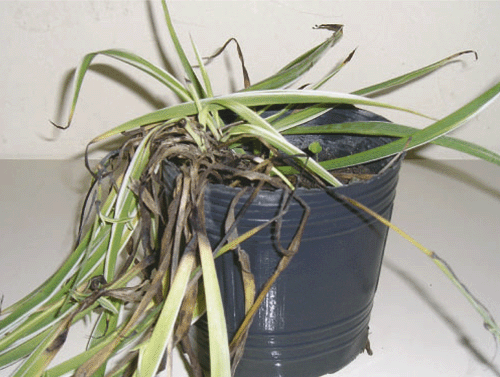First record of Sclerotium rolfsii on Chlorophytum comosum in Argentina
S. A. Gutiérrez A B and M. A. Cúndom AA Cátedra de Fitopatología, Facultad de Ciencias Agrarias, UNNE, Sargento Cabral 2131, (3400) Corrientes, Argentina.
B Corresponding author. Email: suarroz@yahoo.com.ar
Australasian Plant Disease Notes 1(1) 11-12 https://doi.org/10.1071/DN06006
Accepted: 27 July 2006 Published: 24 August 2006
Abstract
Sclerotium rolfsii was recorded for the first time causing leaf and stem necrosis at the soil level on Chlorophytum comosum in Argentina.
Spider plant [Chlorophytum comosum (Thum.) Jacques] is an ornamental plant cultivated for its attractive leaves and is used as both an interior and exterior plant. In Argentina it is used in public and domestic gardens and is cultivated in commercial nurseries. Diseases reported to infect the species include the genera Alternaria, Cercospora, Colletotrichum, Fusarium, Helminthosporium and Phyllosticta; root mycoses caused by Pythium splendens, Rhizoctonia solani and Sclerotium rolfsii have also been reported on C. comosum (Alfieri et al. 1984; Chase 1987, 1997; Cabrera de Alvarez et al. 1999; Petrone et al. 2005).
During autumn 2005, in a commercial nursery in Corrientes (north-east Argentina), C. comosum plants were detected showing leaf and stem necrosis at the soil level, with darkening and tissue disintegration, advancing towards the apex and causing defoliation and death (Fig. 1). White mycelia and small sclerotia were present at the base of infected plants. The sclerotia were globose, initially white and later light brown (150–200 µm diameter). Based on the morphological features, the causal fungus was identified as Sclerotium rolfsii Sacc.

|
The diseased material was later cultivated on potato-glucose agar medium (PGA, 1.5%), pH 6. Morphological and cultural features of the causal agent were studied. Pathogenicity tests were conducted by inoculating healthy spider plants grown in pots with S. rolfsii. Discs of the inoculum growing on the PGA medium were placed at the base of the plants, with and without injuries produced with a sterile needle. The discs were attached to the plant with a piece of cotton moistened with sterile water. The corresponding controls were performed by inoculation with sterile PGA. Inoculated and non-inoculated plants were covered with plastic bags and kept under laboratory conditions for 48 h at 25°C. The plastic bags were then removed and the plants were maintained in a greenhouse where temperatures ranged between 25 and 30°C. After 5–6 days of inoculation, symptoms similar to those occurring naturally were observed. Plants inoculated with needle injuries showed a greater level of infection to S. rolfsii. The fungus was reisolated from the tissues.
S. rolfsii is a soil-borne fungus with a wide host range, including more than 500 plant species, mainly dicotyledons. Among these hosts are numerous ornamental species from tropical and subtropical regions in the southern United States of America, Central and South America (Punja and Rahe 1992; Chase 1987, 1997). The disease is known as southern wilt and southern stem rot. Its pathogenic activity becomes apparent when the hosts are in highly humid places for extended periods. The pathogen can produce symptoms on different parts of the affected plant, but more frequently on stems and leaves close to the soil line (Chase 1997).
This is the first report of S. rolfsii on C. comosum in Argentina.


